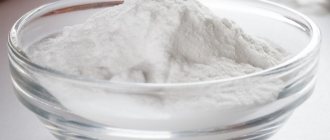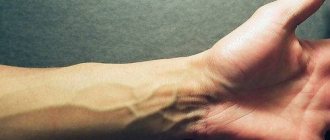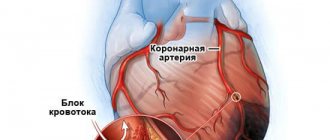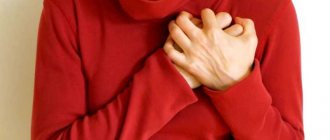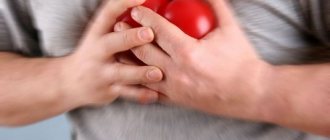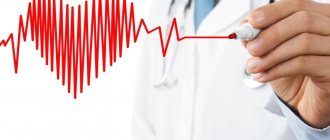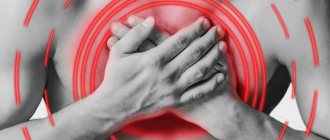Painful sensations of varying intensity and localization accompany a person throughout his life. Of particular concern are heart pains radiating to the left arm, as they can arise for a variety of reasons.
It is important to recognize the course of the pathology in a timely manner, as this can lead to serious health problems or even lead to death.
Angina pectoris
With angina, discomfort appears behind the chest, most often during physical exertion or severe stress. Pain sensations move to the left side of the body, that is, the arm, neck and even jaw. The patient feels a pinched heart. There is also pain in the heart area and my left arm and leg are numb. If the symptoms begin to intensify, then panic fear of death appears. Angina pectoris lasts no more than 10 minutes, so it should not be confused with other diseases. To alleviate the condition, it is recommended to take Nitroglycerin and calm down. If these recommendations are followed, the attack goes away without medical attention. As a preventative measure, preference should be given to medications that help strengthen and restore the body’s core muscles.
How to treat shoulder and forearm pain at home
Inflammatory processes in the shoulder joint lead to pain that can debilitate a person over a long period.
The ability to work decreases, sleep deteriorates, and the person gets tired.
If you are convinced that the cause of shoulder pain is not so serious as to require hospitalization, then it is possible to alleviate the condition at home.
Medications
For each disease, a number of medications are used. Depending on the severity and cause of shoulder pain, you should choose the following medications.
| Disease | Medicines | Ointments, gels |
| Neuralgia, osteochondrosis | Ibuprofen costs an average of 74 rubles. Diclofenac, average price - 65 rubles. | Fastum-gel 30g, average price - 229 rubles. Voltaren-gel 20 g, average price - 220 rubles. |
| Tendobursitis, capsulitis | Ketoprofen, price - 165 rubles. Ibuprofen, average price - 74 rubles. | Vishnevsky ointment, average price - 40 rubles. Methyl salicylate, average price - 105 rubles. Diclofenac 30 g, average price - 48 rubles. |
| Rheumatoid arthritis | Leflunomide, 20 mg No. 30, price varies from 1106 to 1198 rubles. Aceclofenac, 120 rub. | Indomethacin, 40 g, average price - 75 rubles. Viprosal, 50 g, average price - 282 rubles. |
| Humeroscapular periarthritis | Nimesil, 1 sachet, average price - 30 rubles. Diclofenac, cost - 65 rubles. Structum, 500 mg, average price ranges from 1290 to 1370 rubles. | Novocaine injections in combination with hydrocortisone. |
Massage
An effective and useful remedy is general massage, which improves blood circulation and relaxes muscles.
When performing a massage on a sore joint, you need to remember that you cannot knead it, but only stroke it , and the manipulations should not be carried out directly on the damaged area, but near it.
For glenohumeral periarthritis, you can massage the area of the diseased joint, as well as the chest and collar area.
This will reduce pain, normalize muscle tone, restore the functionality of the shoulder joint, and also prevent further progression of the disease.
A massage session is carried out with warming preparations ; usually a massage course includes about 10 sessions.
And to increase the effect of treatment, it is recommended to use special pillows and rollers that have a massage effect.
Massage at home can be done only with the permission of the attending physician , otherwise you can only do harm and get serious complications.
Traditional methods and recipes for treating shoulder joints
Before starting drug treatment, you can try using alternative medicine methods. But it should be borne in mind that they can only help with minor pain.
| Illness | Treatment options |
| Tendobursitis | Cooling compresses using alcoholic tinctures of lavender or peppermint. With their help you can reduce swelling and reduce blood pressure. |
| Sprain | To warm up the muscles and restore the elasticity of the ligaments, alcohol compresses with honey and pepper are used, which improve the functioning of blood vessels in the joint tissues. |
| For pain in the left shoulder and forearm | Baths with the addition of pine needles or a decoction of young pine cones. They are boiled in a glass of water for half an hour, then poured into a thermos overnight. For a bath of this infusion you need 0.5 liters. The duration of such a bath is at least 20 minutes. Compresses from a vinegar solution: add a tablespoon of six percent vinegar to 1/2 liter of water. Soak a clean cloth in the solution, place it on the sore spot and wrap it with a woolen scarf. Make a mixture of leaves in the following quantities: 2 parts black currant, 1 part rose hips, 1 part raspberries, 1 part lingonberries. Pour 2.5 tablespoons of the mixture into one liter of water. Boil for at least 10 minutes and then leave for about 4 hours. Take the decoction on an empty stomach four times a day, half a glass. |
Vascular obstruction
Often, patients have vascular obstruction, so the body does not receive enough nutritional components through the blood. When a spasm occurs, certain parts of the muscle immediately begin to die. Symptoms include a burning sensation, as well as severe pain on the left side. If you take a drug to dilate blood vessels, it will not give the desired effect. In some cases, on the contrary, the signs will only increase. It is important not to hesitate and immediately take measures to hospitalize the person.
Signs
Signs make themselves felt already 10 days after the onset of the disease. The patient almost always experiences the following symptoms:
- tingling inside;
- pain syndrome moves to the left side;
- there is a loss of strength and a broken state;
- sweating increases significantly;
- when moving the body, a number of unpleasant sensations appear, causing difficulty breathing;
- temperature rises;
- problems with night sleep begin;
- heart rhythms are intermittent.
It is important to remember that symptoms intensify only at a moment of complete rest. The development of asthenia should be considered as the first signal, but not all patients are ready to immediately see a doctor. Most often, attention is paid to health after about a week. However, during this time the disease progresses to an advanced stage, and now long-term treatment and recovery will be required. Do not forget that the disease manifests itself only at a moment of rest.
Symptoms
If the pericardial sac is in an inflamed state, this indicates the presence of an infectious, fungal or bacterial disease. This also includes problems of an autoimmune nature. This process is characterized by the accumulation of fluid between the surfaces of the pericardium. As a result, a “motor” tamponade is formed. The organ can no longer contract in the same rhythm, so signs of heart failure occur. These include:
- labored breathing;
- paleness of the skin;
- development of dizziness;
- numbness of the left hand;
- dry cough;
- swelling of the lower extremities of the body;
- strong feeling of thirst;
- possible loss of consciousness.
If the patient does have pericarditis, the doctor can easily determine it due to the distinct noise. It appears as a result of friction of the pericardial walls.
The exact causes of cardiomyopathy have not yet been established. Typically, this diagnosis is made to those patients who do not have a congenital malformation or valve defect. If a disorder begins in the myocardium, this will lead to disturbances in the functioning of the heart. The patient often feels tingling and aching pain, as well as numbness on the left side of the body and sleep disturbances.
Stroke is usually understood as changes in the functioning of the brain, which are closely related to insufficient blood flow to its individual areas. Quite often this condition occurs when:
- blockage of blood vessels, that is, there is an acute lack of nutritional components, and the brain experiences hypoxia (the type of disease is ischemic);
- aneurysm of the vessel (a hematoma appears and a more severe course of the disease occurs).
Impaired body functionality depends on the affected area.
If we talk about general symptoms, here are:
- constant feeling of dizziness;
- partial problems with speech, memory and vision;
- loss of sensation in the limbs;
- the occurrence of a constant feeling of weakness or loss of consciousness;
- muscle spasms.
Features of different diseases
Sometimes such diffuse pain in the arm can be relieved on your own, for example, if it appears due to overwork. But most often the patient himself cannot determine the cause of the pain. After all, they can arise as a result of a variety of pathologies. Only a specialist can understand the specific manifestations of the disease. You can first determine why your hand hurts. But to do this, you need to understand the characteristics of different pathologies.
Spinal diseases
Nerve fibers that innervate the upper limbs depart from the spinal cord in the cervical region. If these nerves are damaged or pinched, pain in the hands occurs. They can be quite intense, sharp, burning. Every movement of the head or hands leads to their strengthening. Additionally, headaches, dizziness, and fluctuations in blood pressure are observed.
Often this condition develops with osteochondrosis of the cervical spine. This pathology occurs mainly in older people, with metabolic disorders or due to increased stress on the neck. In this case, the intervertebral discs begin to collapse, the vertebrae come closer together and compress the nerve fibers. The pain spreads along the nerve. It usually reaches the elbow, but can even affect the fingers. At the same time, numbness, muscle weakness, and paresthesia may be felt.
The same condition is observed with a herniated disc, when its protrusion leads to pinching of nerve fibers. In this case, a lumbago occurs, the pain spreads from the spine to the arm. Spondylosis, characterized by the formation of growths on the edges of the vertebrae, also leads to similar sensations. Aching pains, numbness, tingling, and a feeling of goosebumps appear.
Joint diseases
Acute pain occurs due to inflammatory processes in the joints. Arthritis can occur due to infection, after injury, or with autoimmune pathologies. One joint or several may be affected. Scapulohumeral periarthritis or rheumatoid arthritis often occurs on the upper extremities. Moreover, the joints of the fingers are most often affected, but the pain can spread throughout the entire arm.
Another pathology that affects the joints is arthrosis. The disease usually affects the shoulder and elbow joints of the right hand. After all, they bear increased loads during any activity. In older people, the joints of both hands may be affected, which is associated with metabolic disorders.
Injuries
Your arm may also hurt due to injury. Any damage to bones, joints or muscles causes pain that can spread throughout the arm. This may be a fracture, dislocation of the shoulder, elbow or wrist joint, sprain or rupture of muscles or ligaments.
It is easy to recognize this pathology, since pain occurs immediately after the injury. The damaged area swells, a hematoma appears or the skin turns red. In severe injuries, deformation of the limb is visible. The pain usually gradually intensifies and prevents any movement of the arm.
One of the most common causes of diffuse pain in the arm is injury.
Inflammatory diseases
Most often, arm pain occurs due to muscle inflammation. It can appear due to hypothermia, after injury or increased stress. Athletes and people who work with their hands often develop epicondylitis. This pathology affects the muscle fibers in the area of their attachment to the humerus. The pain spreads throughout the forearm, sometimes reaching the shoulder. In addition, pain throughout the arm can spread due to bursitis of the elbow joint, tendonitis.
How to diagnose a stroke?
When a person suspects a stroke, it is recommended to ask:
- smile (asymmetry is noticeable);
- open your mouth, show your tongue (will be curved);
- ask something quite simple (speech becomes incoherent);
- raise your hands up (happens extremely unevenly).
If characteristic signs are detected, you should immediately call an ambulance. With a large loss of time, serious complications can develop. In some cases, a person becomes permanently disabled.
Home treatments
In cases of injury or suspected acute heart failure or other pathologies of the cardiovascular system, self-medication is unacceptable; it is important to call an ambulance as quickly as possible.
You can relieve heaviness in your hands at home if it is caused by diseases of the spine, myositis, or degenerative diseases of the joints. The following will help reduce discomfort:
- gymnastic exercises: swinging your arms up and down, shaking them, at least 5-6 times;
- massage or self-massage: light stroking and pinching in the up and down direction, 10-15 minutes.
Neuralgia
Pain in the heart and numbness in the arm do not always indicate problems with this organ. There are also other reasons that provoke the appearance of such ailments.
First of all, we need to highlight neuralgia. This disease affects the peripheral nervous system. Most pain is observed with intercostal pathology. A burning sensation appears in the chest, and shooting pain appears in the shoulder girdle. Strengthening occurs after raising the hands, and no heart pills can alleviate the patient’s condition.
The disease develops in the presence of appropriate factors.
- The man suffered severe hypothermia.
- Strong physical labor is performed.
- You have previously had an infectious or viral disease.
- When the intervertebral disc and cartilage are damaged, metabolic processes and the functioning of the circulatory system significantly deteriorate. At the very beginning, the discs lose their initial strength and elasticity, and over time they simply dry out. The height will gradually decrease. If a person continues to engage in vigorous physical activity, this will lead to deformation of the fibrous ring or rupture. As a result, an intervertebral hernia may appear, which provokes:
- constant headaches (even migraines);
- pain in the sternum of a pulling nature (radiates to the shoulder blades and increases when raising the arms);
- discomfort when taking a deep breath or when lifting a heavy weight;
- numbness of some parts of the body.
Osteochondrosis manifests itself most in the evening hours.
Treatment
Therapy for the feeling of heaviness in the hands is based on the treatment of the underlying disease:
- for degenerative processes in the spine and joints, anti-inflammatory and painkillers, chondroprotectors and physiotherapy are used;
- for endocrine diseases, hormone replacement therapy, diet, and sedatives are prescribed;
- Cardiac glycosides and anabolic agents help with heart ailments;
- In case of traumatic injuries, surgical interventions and subsequent rehabilitation measures (physical therapy, massage, swimming) are necessary.
In any case, treatment should only be prescribed by a doctor, after a comprehensive diagnosis.
Cardialgia
Cardialgia is characterized by a recurring or constant nature. True, painful sensations arise not due to damage to any organ, but due to the work of the patient’s subconscious. Strong experiences and feelings of fear can create many unpleasant symptoms. This health problem is called a panic attack, that is, a person is afraid of death due to cardiac arrest. The attacks last for a couple of minutes, but sometimes last for several hours. Symptoms include high blood pressure, a feeling of heaviness, heart pain and numbness in the left arm. After drinking alcohol, these symptoms become more pronounced. Sometimes a person shows a specific place that provokes the development of such signs. No heart medication can eliminate discomfort.
Heart attack
A heart attack is when part of the heart muscle becomes damaged or stops functioning completely due to lack of oxygen.
Most heart attacks occur as a result of narrowing of the coronary arteries. Arteries become narrowed due to plaque buildup on the inner walls. If plaque breaks away from the artery wall, it can cut off the flow of oxygen-rich blood to the heart, which can lead to a heart attack.
Pain in the left arm is one of the most common symptoms of a heart attack. The nerves that come from the heart and the arm send signals to the same areas of the brain. As a result, the brain is unable to isolate the source of pain.
This phenomenon is called referred pain and explains why a person who has had a heart attack may feel pain in their arm without experiencing chest pain.
Seek emergency medical help immediately by calling 112 if sudden pain in your left arm gets worse within a few minutes or occurs along with the following symptoms:
- discomfort in the central part of the chest that lasts longer than a few minutes or disappears and then returns;
- pain, numbness, or unusual discomfort in your back, neck, jaw, or lower abdomen;
- shortness of breath with or without chest pain;
- stomach upset;
- nausea or vomiting;
- dizziness;
- sudden cold sweat or fever with facial flushing
Read also: 5 reasons why your face turns red after eating and what to do about it
Chest discomfort is the most common symptom of a heart attack in both men and women. It takes the form of pressure, tightness, stuffiness, burning or gradually increasing pain.
However, women are more likely than men to experience other symptoms during a heart attack, such as shortness of breath and nausea. They may incorrectly attribute these symptoms to a virus, digestive problems, or stress.
If you experience a sudden combination of nausea, vomiting, shortness of breath, or pain in your lower abdomen, back, or jaw, seek medical attention immediately.
What should I do if my heart hurts and my left arm goes numb?
If pain occurs in the area of the heart and, along with this, numbness of the left side begins, then the current situation should not be ignored. It is better to consult a specialist, and this should be done even with minor symptoms. This will help prevent the development of complications and begin treatment in a timely manner. Under no circumstances should you self-medicate; only after an examination, the doctor will select the appropriate course. In any case, it is better to prevent a disease than to treat it.
Source

